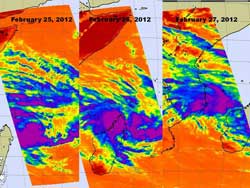Three Days of NASA Infrared Images Show System 92S Tropically Developing

The AIRS instrument on NASA's Aqua satellite captured infrared imagery on developing System 92S in the Mozambique Channel (Indian Ocean). On February 25 at 0941 UTC, System 92S was moving west toward Madagascar. By February 26 at 10:23 UTC System 92S was over northwestern Madagascar. On February 27 at 1105 UTC had moved into the Mozambique Channel and appeared to be heading for a landfall in Mozambique.<br>Credit: NASA/JPL, Ed Olsen <br>
The Atmospheric Infrared Sounder (AIRS) instrument on NASA's Aqua satellite captured infrared imagery on developing System 92S as it moved from the Southern Indian Ocean, west across northern Madagascar and into the Mozambique Channel.
On February 25 at 0941 UTC, System 92S appeared as a rounded low pressure area with the strongest storms (and highest, coldest cloud tops on AIRS infrared imagery) south of the center of circulation. It was still in the open waters of the Southern Indian Ocean and was moving west toward Madagascar. By February 26 at 10:23 UTC System 92S was raining on northern Madagascar.
On February 27 at 1105 UTC had moved into the Mozambique Channel and appeared to be heading for a landfall in Mozambique. On the 27th, the strongest thunderstorms and coldest cloud tops appeared in two areas, north and east of the storm's center.
On February 27, the center of System 92S was located in the Mozambique Channel, near 13.5 South and 48.5 East, about 345 nautical miles north-northeast of Antananarivo, Madagascar. AIRS infrared imagery indicated that the low had weakened because of its interaction with land, as it moved over northern Madagascar.
Now that the center of System 92S is over the warm waters of the Mozambique Channel, it is expected to redevelop quickly. The area of strong thunderstorms east of center, as seen on AIRS imagery is a band of thunderstorms.
The Joint Typhoon Warning Center gives this system a high chance for developing further into a tropical cyclone in the next 24 hours.
Text Credit: Rob Gutro
NASA's Goddard Space Flight Center, Greenbelt, Md.
Media Contact
All latest news from the category: Earth Sciences
Earth Sciences (also referred to as Geosciences), which deals with basic issues surrounding our planet, plays a vital role in the area of energy and raw materials supply.
Earth Sciences comprises subjects such as geology, geography, geological informatics, paleontology, mineralogy, petrography, crystallography, geophysics, geodesy, glaciology, cartography, photogrammetry, meteorology and seismology, early-warning systems, earthquake research and polar research.
Newest articles

Machine learning algorithm reveals long-theorized glass phase in crystal
Scientists have found evidence of an elusive, glassy phase of matter that emerges when a crystal’s perfect internal pattern is disrupted. X-ray technology and machine learning converge to shed light…

Mapping plant functional diversity from space
HKU ecologists revolutionize ecosystem monitoring with novel field-satellite integration. An international team of researchers, led by Professor Jin WU from the School of Biological Sciences at The University of Hong…

Inverters with constant full load capability
…enable an increase in the performance of electric drives. Overheating components significantly limit the performance of drivetrains in electric vehicles. Inverters in particular are subject to a high thermal load,…





















